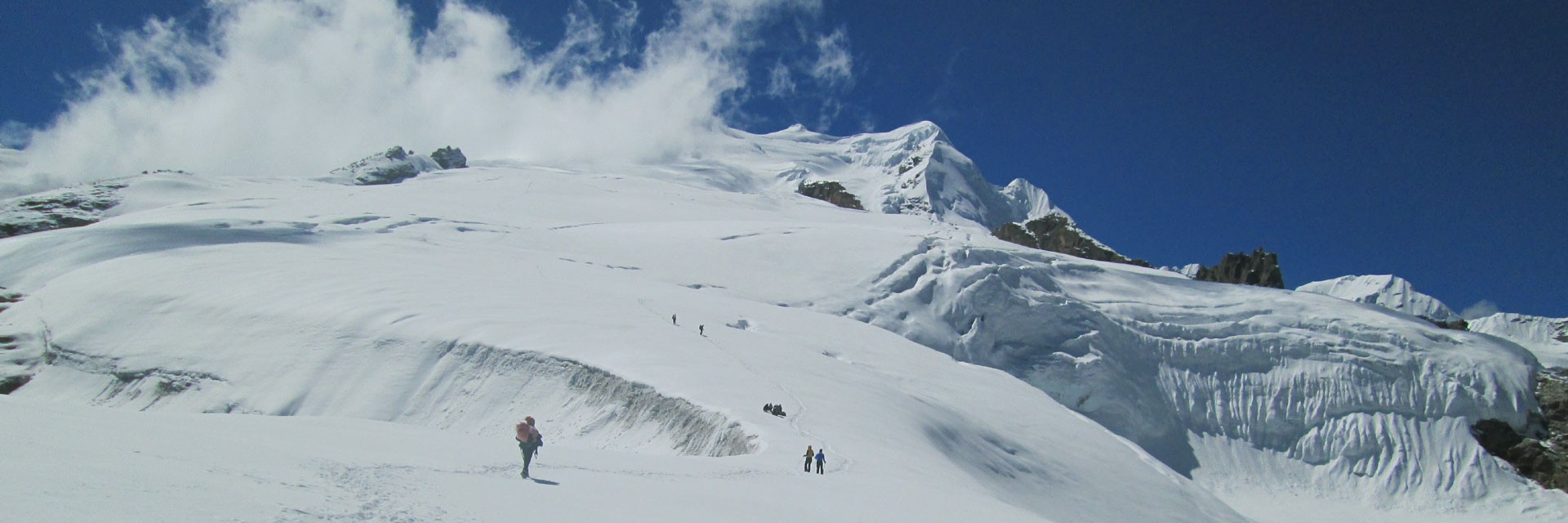Are you interested in climbing Mt. Island Peak? Wondering what it is like to be on one of Nepal’s iconic peak? Here are some important things you need to know before booking your Island peak climbing:
Island Peak Climbing is not a technical. It’s just a long walk.
When people dream of climbing peak, they make the images of difficult routes clinging to a vertical rock-face with a threat of fall to the earth below. Or an alpinist dressed from top to bottom in a thick suit, taking step after step in deep snow, axe in hand and ascending slowly and tightly along the ropes.
Don’t think too much in case of Island Peak. It is highly achievable peak even for novice. With some prior preparation and technical training, the formidable height and climbing trail won’t bother you.
With 6,189m height, Island Peak is one of the easiest trekking in Nepal with straight forward climbing routes and less technical section. Don’t get afraid of technical parts, your experienced climbing guide will make it easy for you.
Island Peak Climbing Expeditionsare fully supported
Mt. Island Peak climbing expeditions are fully supported; meaning that a highly professional team of guides, cooks and porters will accompany you throughout the journey. The helping crew will set up the tents, undo the tents, cook fresh food, fetch the water and clear the campsite. So that you can use your esteem energy in the climbing expedition. Porter will carry all the climbing gears, Kitchen gears and every your personal belongings. Cook will prepare you a fresh food for you.
Acute Mountain Sickness is dangerous
The air gets thinner as you gain the height. If you ignore the rules of height, you are likely to get victim of altitude sickness. AMS is the main reason that people are unsuccessful to summit the Island Peak.
AMS happens to your body when your body is unable to adapt to the lower oxygen levels at alpine elevation. So you need a meticulously designed itinerary with ample acclimatization period which creates the biological responses to combat the oxygen deficiency.
Symptoms of AMS usually begins with a light headache, feeling of nausea and fatigue. If your body experiences these symptoms, descend down to lower elevation and do not rise until your body is fully recovered. If these symptoms are ignored, you can be victim of High Altitude Pulmonary Edema (Hape) and High Altitude Cerebral Edema (HACE) which can lead to death or coma.
The key to avoid AMS is to walk on slow pace, stay hydrated and acclimatize the body well.
Need to Buy Climbing Permit and Sagarmatha National Park Permit
A trekking and climbing permit are required before you start your journey to Mt. Island Peak. You need to buy Sagarmatha National Park Permit, TIMS (Trekking Information Management System) Card and Island Peak Climbing Permit.
The Island Peak Permit cost for a group up to four climbers us USD 350 with additional cost of USD 40 per person. Add to this, you need to pay USD 250 to ensure compliance with garbage regulation and it is refundable after your expedition.
Hire a Guide And Porter
If you are planning to climb Island Peak independently, then you are definitely risking your life. It implies to even for seasoned trekkers. You must hire a guide and porter. Though seasoned trekkers are well-equipped with the knowledge, they don’t know the route. Sometime are crevasses are covered with snows and new crevasses are formed which can be noticed only by a regular guide. Moreover, porter will give you a good space to walk light and free.
The Island Peak Head Wall and Summit
From Island Peak Base Camp, you will walk on via glacier and moraine to high camp and traverse a steep ravine. You have to put on the crampons for here onward. The final part before summit is full of challenge – you have climb steeply to head-wall. The head-wall is 300m ascend along with inclination of 40 to 50 degrees. No worries, your professional Sherpa guide will fix a rope whenever necessary. Ladder as used to cross difficult crevasses.
Avoid Spring Snowfall and Winter Winds
The month December to mid-February gets severely cold with heavy snowfalls and strong chilly winds – leading the temperature to minus 40 degree celsius in the summit. Likewise, the month of spring (February to March) becomes challenging for climbers due to fresh snow on the summit. However, the months starting from March to May and September to November brings favorable climate to summit the Island Peak.
On summit day you will start very early:
On summit day, you have wake-up at around 1 – 2 AM and prepare yourself for expedition with the aim the summit the peak by 9 – 10 AM. The early start is necessary to avoid the strong afternoon winds and chilly evening weather.
Everest Base Camp is so close!
Why not conquer the most popular trekking destination if it is just two walking days away from Island Peak. Make sure to add the Island Peak Climbing with Everest Base Camp Trek for more fun, adventure and discoveries. You have to pay little extra if you intend to trek Everest Base Camp too.
Training is highly recommended
Island Peak summit expedition does not require you to be an athlete but an adequate fitness and bit pre-climbing training is indeed required. Train yourself engaging on cardiovascular exercise, weight resistant training and hill trekking with some loads on back. These training will immensely pay you back.
Get some buffer days
The weather of mountains are highly unpredictable. The climate can get worse in very short time period. Getting some buffer days will compensate the flight delays and cancellation. Also, it compensate your itinerary if you have to wait for good weather in base camp.

